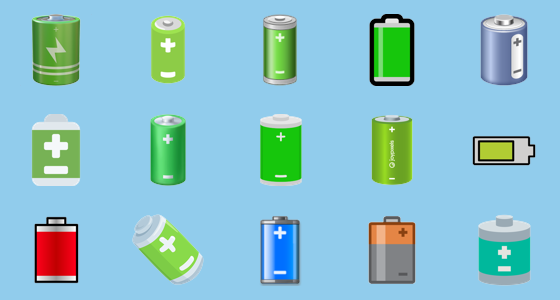The choice of battery energy storage routes is rich, including at least: lead-acid (lead-carbon batteries), lithium-ion batteries (ternary, lithium iron phosphate), supercapacitors, nano-based batteries, liquid-flow batteries, sodium-sulfur batteries, etc. In the dizzying array of battery technologies, how should energy storage users and integrators make their choices; What principles should design solutions and long-term planning?
1, The choice of battery type
With the development of battery technology and the rapid decline in cost, lithium batteries have become the mainstream choice in household energy storage projects, with a market share of more than 95% of new chemical batteries. Compared with lead-acid batteries, lithium batteries have the advantages of high efficiency, long cycle life, accurate battery data, and consistency.
2, The battery capacity design has four common misconceptions
(1) Select battery capacity only according to load power and power consumption
In the design of battery capacity, the load situation is the most crucial reference factor. But the battery charging and discharging capacity, the maximum power of the energy storage machine, the load’s power consumption period, and so on should not be ignored.
(2) Theoretical capacity and actual capacity of the battery
Usually, the battery manual is marked above the theoretical capacity of the cell. That is in the ideal soil the battery is from SOC100% to SOC0% when the battery can release the maximum power. In practice, looking at the battery life, it is not allowed to discharge to SOC 0%, which will set the protection power.
(3) The battery capacity selection.
In practical applications, consider the battery usage rate. If the PV system capacity is small or load power consumption is large, the battery can not be filled which causes waste.
(4) The battery capacity is designed to fit perfectly
Due to the process loss, the battery discharge is less than the battery storage capacity, and the load consumption is less than the battery discharge capacity. Ignoring the efficiency loss is likely to cause the phenomenon of insufficient battery power supply.
3, The battery capacity design under different application scenarios
This article introduces the battery capacity design ideas for three common application scenarios: self-generation (higher electricity costs or no subsidies), peak and valley tariffs, and backup power (unstable grid or with material loads).
(1) “Self-generation and self-consumption”
Due to higher electricity prices or PV grid-connected subsidies being low (no subsidies), install a PV energy storage system to reduce electricity expenses. Assuming a stable grid, do not consider off-grid operation PV to reduce grid electricity consumption is generally more light during the day; The ideal soil is that the PV + storage system can completely cover household electricity consumption. But this situation is difficult to achieve. So we take into account the input cost and electricity consumption. You can choose the battery capacity according to the average daily household electricity consumption (kWh) (default PV system energy sufficient). If we can accurately collect the electricity consumption law, combined with the energy storage machine management settings, we can try to improve the system utilization.
(2) Peak and valley electricity price
Daytime electricity consumption is low (a PV system can cover it). During the peak electricity consumption period, it is necessary to ensure that at least half of the electricity is supplied by the battery to reduce electricity expenses.
Assume that the average daily electricity consumption during the peak period: 20kWh. The maximum demand value of battery capacity is calculated based on the total electricity consumption during the peak period. Then find an optimal battery power within that interval based on the status of the PV system and the benefits of the investment.
(3) Unstable grid area – standby power
In early 2017, Goodway once designed a project in Southeast Asia; The details are as follows.
Application site: chicken farm considering PV playable area about 5-8KW modules can be installed
The vital load: ventilation fan, the power of a single fan is 550W (if the ventilation fan does not work, the oxygen supply in the chicken shed is insufficient)
Power grid situation: unstable power grid, irregular power outages, the longest power outage length of 3~4 hours
Application requirements: under normal grid conditions, the battery is charged first; when the grid is blacked out, the battery + PV ensure the standard operation of crucial loads (fans)
When selecting the battery capacity, all that needs to be considered is the amount of power required for the battery to supply alone in an off-grid situation (assuming an evening power outage and no PV). The total power used when off-grid and the expected time off-grid are the most critical parameters. If there are other loads in the system, all of them need to be listed. And then the required battery capacity is finally determined based on the maximum power consumption load power and electricity consumption during the longest continuous power outage hours throughout the day.
4, The battery capacity design in two significant factors
(1) photovoltaic system capacity
Assumptions: the battery is all charged by a photovoltaic charging energy storage machine to charge the battery maximum power of 5000W daily sunshine hours for four hours then:
① In the battery as a backup power mode, the virtual capacity of 800Ah battery in the ideal state full of the average need: 800Ah/100A/4h = 2 days
② In the self-generation pattern, it is assumed that the system charges the battery at 3000W on average for 4 hours per day; The battery with a valid capacity of 800Ah needs to be fully charged (without discharging): 800Ah*50V/3000=13 days to meet the daily power consumption of the load. And the battery cannot be fully charged under the conventional self-generating and self-consumption system.
(2) Battery redundancy design
The three application scenarios mentioned earlier all mention that due to the instability of photovoltaic power generation, line loss, ineffective discharge, battery aging, and other causes of efficiency loss, in the battery capacity design, it is necessary to retain a certain amount of margin; The design of the battery allowance is relatively free; Designers can make a comprehensive judgment according to the actual situation of their own system.
Summary
In this paper, we have introduced battery capacity design solutions for several common application scenarios. It can be seen that the three scenarios are designed with similar ideas and fixed core conditions, but different factors need to be considered in unusual plots.
If you want to know more about energy storage consultation, please feel free to consult: www. enetcl.com.At the same time, we also hope you can give us valuable advice or suggestions. Thank you!



